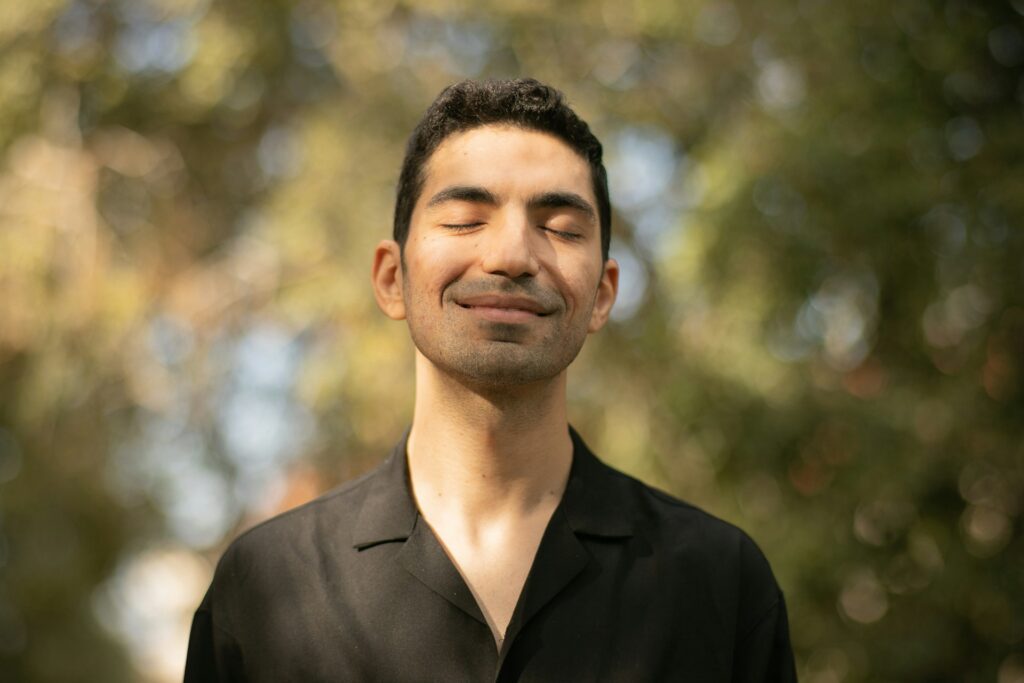Gratitude doesn’t ask you to pretend everything is perfect.

In reality, it’s all about making space to notice what’s already working, however small, and appreciating the good things in your life. The more you practise it, the more it reshapes how you move through the day. You’re not forcing positivity here; you’re choosing to see clearly and focus on the good things. If changing your mindset that way sounds a bit too challenging at the moment, these tips might help.
1. Start by noticing the things that don’t go wrong.

Most of our attention goes to the problems, delays, and annoyances. Of course, behind the scenes, a lot of things go right every single day—the bus that showed up on time, the stranger who held the door, the meal that digested without issue.
Acknowledging these moments doesn’t mean life is perfect. It just trains your brain to see stability and support where you’d normally find nothing at all. Gratitude grows when you begin noticing the invisible scaffolding that’s holding you up more than you realised.
2. Keep a running list, but make it personal.

Gratitude journals are often suggested, but they can start to feel mechanical if you write down the same three things every day. The key is to notice why something matters to you. What did it change in your mood, your day, or your sense of safety?
It doesn’t have to be long or poetic. A simple sentence like, “I felt more myself after that conversation,” or “I actually enjoyed walking today,” builds a meaningful list. Gratitude deepens when it feels like your experience, not a performance.
3. Create small moments of deliberate pause.

Gratitude needs space. If you move from one task to the next without slowing down, your brain doesn’t get the chance to register the good stuff. A bit of a break, even 30 seconds, can turn a normal moment into something grounding. Whether it’s a cup of tea, sunlight through a window, or the quiet after a long day—make room to notice it. Not just mentally, but physically. Let yourself sit in it for a beat longer than usual. That’s where gratitude sneaks in.
4. Reflect on what past-you once hoped for.

Some of the things you have now were once things you really wanted—stability, a place of your own, a healthier relationship with yourself. However, as soon as we adjust to something, it becomes the new baseline, and we stop appreciating it.
Looking back can remind you of how far you’ve come. It doesn’t mean you stop wanting growth—it just softens the part of you that always thinks it’s not enough. Gratitude often starts by realising you’re already living inside some of your old wishes.
5. Take gratitude off the page and into conversation.

It’s one thing to feel grateful—it’s another to speak it. Telling someone that you appreciated their help, their tone, their effort, or their time can strengthen your connection and reinforce the good feeling for both of you. You don’t need grand declarations. A small “thank you for showing up today” or “I really appreciated that” goes a long way. Gratitude that’s shared often sticks longer than gratitude that stays silent.
6. Let your body feel gratitude, not just your mind.

Gratitude isn’t just a mental exercise—it’s also a physical state. When you genuinely feel grateful, your breath slows, your muscles soften, and your nervous system moves into calm. That’s something worth cultivating. Take a moment each day to notice how it feels to be safe, supported, or seen. Let your shoulders drop. Let your breath deepen. These small signals help your body associate gratitude with relaxation, not pressure or forced optimism.
7. Stop comparing your gratitude to someone else’s.

It’s easy to feel like you’re doing gratitude “wrong” if yours doesn’t look deep or spiritual or profound. The thing is, gratitude doesn’t have to be poetic. It can be “my socks are warm” or “the train wasn’t packed.” The point is not how it sounds—it’s that it feels real to you. You’re not trying to impress anyone. You’re just building a more honest relationship with your day. That’s what makes the practice actually work.
8. Change the question from “What am I grateful for?” to “What brought me ease today?”

Sometimes the word “gratitude” feels heavy, especially on hard days. Reframing the question can help. Look for what gave you ease, relief, comfort, or lightness, however brief. Maybe it was a moment of eye contact, a message that made you smile, or five minutes of stillness. Gratitude becomes easier when you stop reaching for grand feelings and start spotting the small things that helped you breathe a little easier.
9. Use contrast to remind yourself what’s working.

You don’t need to dwell in pain to feel thankful. But sometimes, thinking about what could be worse—or what once was worse—can re-centre your perspective. That doesn’t mean toxic positivity. It just means balance.
Maybe your back didn’t hurt today. Maybe you didn’t feel anxious this morning. Maybe you finally slept through the night. These aren’t dramatic wins, but they’re important. Gratitude sharpens when you allow contrast to bring the quiet victories into focus.
10. Let it be imperfect, inconsistent, and honest.

You won’t feel grateful every day. Some days you’ll forget. Some days you’ll try and it’ll feel hollow. That doesn’t mean it’s not working. Gratitude is like a lens—it gets clearer the more you practise using it, even if it fogs up sometimes. Let it be messy. Let it feel small. What matters is that you keep reaching for it in a way that feels natural, not forced. As time goes on, the act of noticing becomes its own reward, and that’s where the real change begins.


